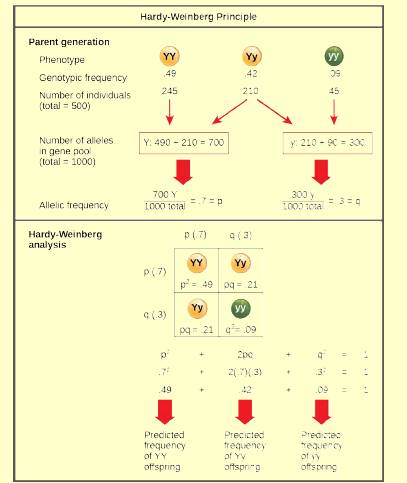
Concept explainers
Figure 19.2 In plants, violet flower color (V) is dominant over white (v). If p = .8 and q = 0.2 in a population of 500 plants, how many individuals would you expect to be homozygous dominant (VV), heterozygous (Vv), and homozygous recessive (vv)? How many plants would you expect to have violet flowers, and how many would have white flowers?


To analyze:
To solve the genetic structure using the Hardy Weinberg principle of equilibrium theory.
Introduction:
The Hardy−Weinberg principle is also known as the Hardy−Weinberg equilibrium, model, theorem, or law. According to principle in the absence of evolutionary influences, the frequencies of allele and genotype in a population will remain constant from one generation to the next generation, hence it also referred to as neutral equilibrium some time.
Explanation of Solution
Hardy-Weinberg Equation.
Where,
p2 depicts the frequency for homozygous genotype VV.
q2 depicts the frequency for homozygous genotype vv.
2pq depicts the frequency for heterozygous genotype Vv.
For a population in genetic equilibrium:
Therefore, the total number of homozygous dominant.
Total number of homozygous recessive is.
Hence, the expected total number of the violet flower is.
The expected total number of white flower (
Thus, the total number of the violet flower is 480 and a total number of white flower is 20.
Want to see more full solutions like this?
Chapter 19 Solutions
Biology 2e
Additional Science Textbook Solutions
Campbell Biology (11th Edition)
Campbell Essential Biology (7th Edition)
Microbiology: An Introduction
Campbell Biology: Concepts & Connections (9th Edition)
Biology: Life on Earth (11th Edition)
Campbell Biology in Focus (2nd Edition)
- What is behavioral adaptarrow_forward22. Which of the following mutant proteins is expected to have a dominant negative effect when over- expressed in normal cells? a. mutant PI3-kinase that lacks the SH2 domain but retains the kinase function b. mutant Grb2 protein that cannot bind to RTK c. mutant RTK that lacks the extracellular domain d. mutant PDK that has the PH domain but lost the kinase function e. all of the abovearrow_forwardWhat is the label ?arrow_forward
- Can you described the image? Can you explain the question as well their answer and how to get to an answer to an problem like this?arrow_forwardglg 112 mid unit assignment Identifying melting processesarrow_forwardGive only the mode of inheritance consistent with all three pedigrees and only two reasons that support this, nothing more, (it shouldn't take too long)arrow_forward
- Oarrow_forwardDescribe the principle of homeostasis.arrow_forwardExplain how the hormones of the glands listed below travel around the body to target organs and tissues : Pituitary gland Hypothalamus Thyroid Parathyroid Adrenal Pineal Pancreas(islets of langerhans) Gonads (testes and ovaries) Placentaarrow_forward
 Human Heredity: Principles and Issues (MindTap Co...BiologyISBN:9781305251052Author:Michael CummingsPublisher:Cengage Learning
Human Heredity: Principles and Issues (MindTap Co...BiologyISBN:9781305251052Author:Michael CummingsPublisher:Cengage Learning Biology: The Dynamic Science (MindTap Course List)BiologyISBN:9781305389892Author:Peter J. Russell, Paul E. Hertz, Beverly McMillanPublisher:Cengage Learning
Biology: The Dynamic Science (MindTap Course List)BiologyISBN:9781305389892Author:Peter J. Russell, Paul E. Hertz, Beverly McMillanPublisher:Cengage Learning Biology 2eBiologyISBN:9781947172517Author:Matthew Douglas, Jung Choi, Mary Ann ClarkPublisher:OpenStax
Biology 2eBiologyISBN:9781947172517Author:Matthew Douglas, Jung Choi, Mary Ann ClarkPublisher:OpenStax Concepts of BiologyBiologyISBN:9781938168116Author:Samantha Fowler, Rebecca Roush, James WisePublisher:OpenStax College
Concepts of BiologyBiologyISBN:9781938168116Author:Samantha Fowler, Rebecca Roush, James WisePublisher:OpenStax College Biology (MindTap Course List)BiologyISBN:9781337392938Author:Eldra Solomon, Charles Martin, Diana W. Martin, Linda R. BergPublisher:Cengage Learning
Biology (MindTap Course List)BiologyISBN:9781337392938Author:Eldra Solomon, Charles Martin, Diana W. Martin, Linda R. BergPublisher:Cengage Learning





